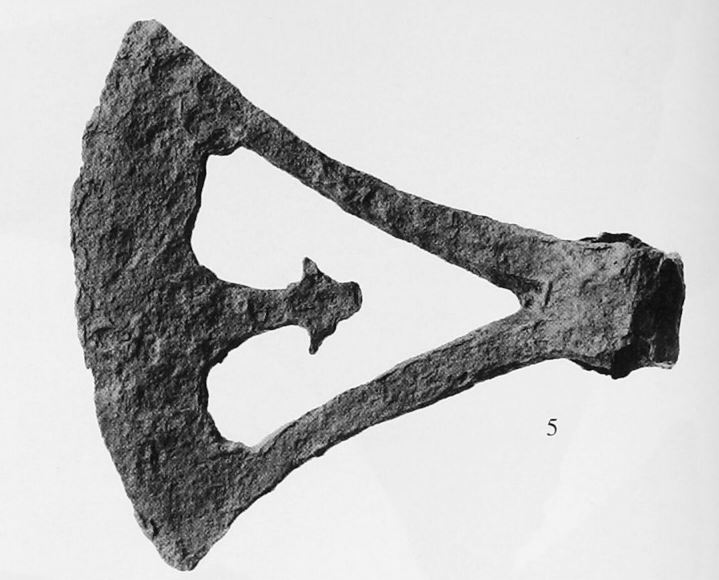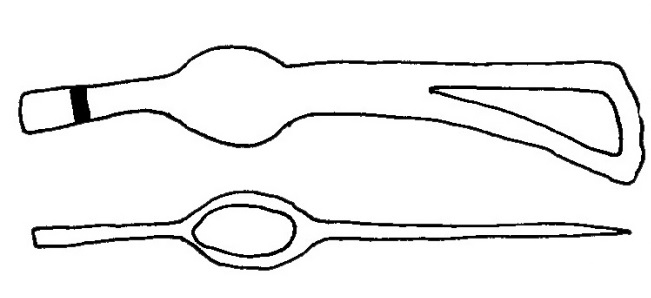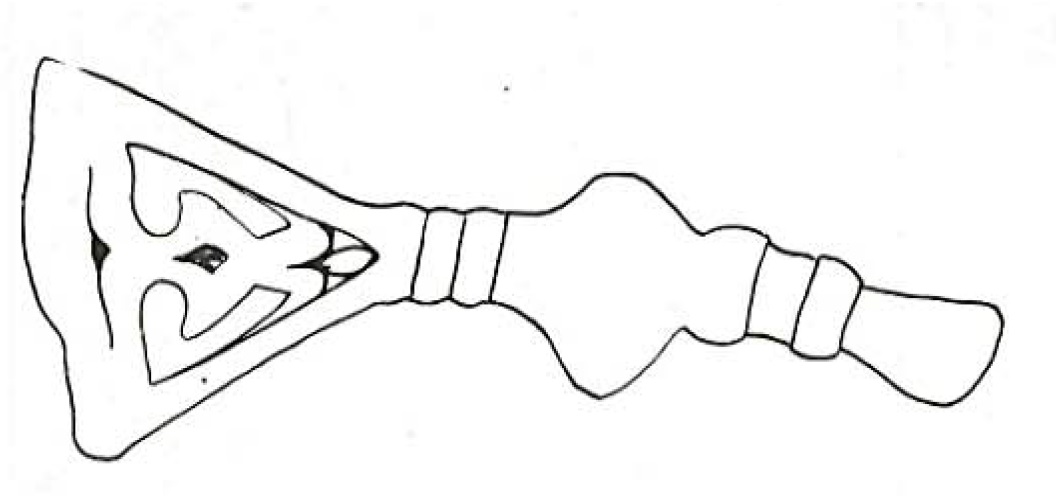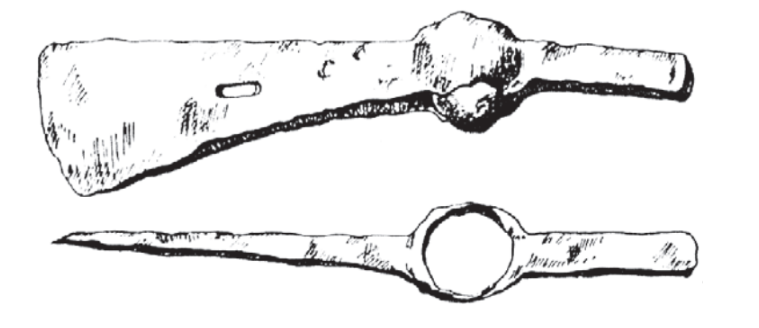Reconstruction of a cross axe. Author: Jakub Zbránek.
In the vortex of battle, we often encounter axes that have an atypical appearance – the center of the blade is cut and in some cases filled with a cross-like or hammer-like protrusion. This popular shape of axes has repeatedly provoked debates about authenticity, so we decided to gather known information into one summary article, the value of which may prove in the future with increasing material.
We will not include axes with one round hole in this article. Single round perforation is a common feature of 10th-13th century Central and Eastern European axes and its meaning can be reduced to two interpretations – the suspension hole for a sheath and decoration originally filled with a contrast metal (Kotowicz 2018: 35-6; Vlasatý 2015; Vlasatý 2020b). In 2023, our article Catalog of 8th-12th century perforated axes dealt with the problem comprehensively (Vlasatý 2023).
Catalogue
The catalog collects a total of 18 European Early Medieval axes, which have more significantly perforated blades. Typologically, they belong to axes of Petersen types L / M, double axes, hammer axes and T-shaped axes.
- Ludvigshave, Denmark
A cross axe of L/M type found in a mound discovered at the end of the 19th century. In the literature, the place is also known as Pederstrup. Axe length 21.9 cm, axe width 18 cm. At present, the axe is stored in the Danish National Museum with inventory number C9115.
Literature: Brøndsted 1936: 181–182, fig. 92:2; Paulsen 1956: 67, fig. 25:c; Pedersen 2014: 31, 74, Find list 2; Roesdahl – Wilson 2000: 279, no. 194.
The axe from Ludvigshave. Source: Natmus.dk.
- Sortehøj, Denmark
A cross axe of L/M type found in a mound discovered in 1831. In the literature, the place is also known as Gjersing. Axe length 18 cm, axe width 17.5 cm. At present, the axe is stored in the Danish National Museum with inventory number NM2866.
Literature: Brøndsted 1936: 121, fig. 63; Pedersen 2014: Find list 2.
The axe from Sortehøj. Source: Natmus.dk.
- Unknown place, central Jutland, Denmark
A cross axe of L/M type found in an unknown context Axe length 23 cm, axe width 22 cm. The neck and the butt are inlayed with copper alloy strips. At present, the axe is stored in the Silkeborg Museum.
Literature: Schiørring 1978.
The axe from Silkeborg Museum. Source: Silkeborg Museum.
- Närke, Sweden
A cross axe of L/M type found in a damaged grave. Axe length 17.5 cm, axe width 16 cm. At present, the axe is stored in the State Historical Museum in Stockholm with catalog number SHM 10243.
Literature: Hansson 1983: 7, 27; Paulsen 1956: 67, fig. 25:b.
The axe from Närke. Source: ATA, Riksantikvarieämbetet Stockholm.
- Stentugu, Hejde, Gotland, Sweden
A cross axe of L/M type, found as a stray find in 1931. Axe length 15.5 cm, axe width 14 cm. At present, the axe is stored in Visby Museum with catalog number GF C 7642.
Literature: Thunmark-Nylén 1998: Taf. 260:5; 2000: 376; 2006: 312.
The axe from Stentugu. Source: Thunmark-Nylén 1998: Taf. 260:5.
- Unknown place, vicinity of Płock, Poland
A cross axe of Kotowicz type IIIA.5.1, probably originating from a damaged grave. The blade of the axe is equipped with a small cross-shaped perforation. Axe length 17 cm, axe width 15.9 cm. At present, the axe is stored in Płock Museum with catalog number VD/128.
Literature: Kotowicz 2013: 51, Fig. 11; Kotowicz 2014: 201-2, Tabl. CLIV.1.
The axe from Płock. Source: Kotowicz 2013: Fig. 11.
- Unknown place, northeastern Bulgaria
One of the double axes of Jotov type 4B from northeastern Bulgaria is equipped with four holes arranged in a cross. No further information is known.
Literature: Jotov 2004: кат. No 582, обр. 51, табло L.

The axe from northeastern Bulgaria. Source: Jotov 2004: кат. No 582, обр. 51, табло L.
- Unknown place, Russia
The Krasnodar Museum in Russia houses an Early Medieval double axe, the blade of which is perforated. The axe has small dimensions. No further information is known.
Literature: Vlasatý 2020a.
The axe from Krasnodar Museum.
Source: Краснодарский государственный историко-археологический музей-заповедник им. Е.Д.Фелицына.
- Bilär, Russia
A double axe with a perforated blade was found in the center of Volga Bulgaria. Axe length 18 cm, blade width 5.2 cm, eye diameter 2-2.5 cm, weight 220 g. Deposited at Kazan Federal University (КГУ), inv. no. АКУ 2-207.
Literature: Chalikov 1985: 182; Izmailov 1997: 77-80, рис. 45.1.
The axe from Bilär. Source: Izmailov 1997: 77-80, рис. 45.1.
- Moldovanovka, Russia
A double axe with a perforated blade measuring 19.5 × 3.8 cm.
Literature: Kočkarov 2006: 20, 22, Прил. 1, Табл. II.
The axe from Moldovanovka. Source: Kočkarov 2006: Табл. II.
- Demenki, Russia
A double axe with a perforated blade measuring 18.1 × 3.6 cm, found in grave no. 18 in Demenki, Perm, in 1953.
Literature: Danič 2015: 112, 117, рис. 11. 57.
The axe from Demenki. Source: Danič 2015: рис. 11.57.
- Unknown place, southern Ukraine
A double axe with a perforated blade was found during illegal detector activity in 2015 and sold to a private collector. The axe was allegedly found in the grave along with another military, while the attached helmet was a fake.
Literature: unpublished.
The axe that was illegally digged in southern Ukraine.
- Unknown place, Sweden
A hammer axe of Kotowicz type IA.6.33 with perforations that forms palmette-shape decoration. The dimensions of the axe are about 10-11 cm × 4.5-5.5 cm. The current state of the find is unknown, the last place of storage was the Falköping Museum.
Literature: Paulsen 1956: 40, 64, Abb. 25d; Vlasatý 2020a.
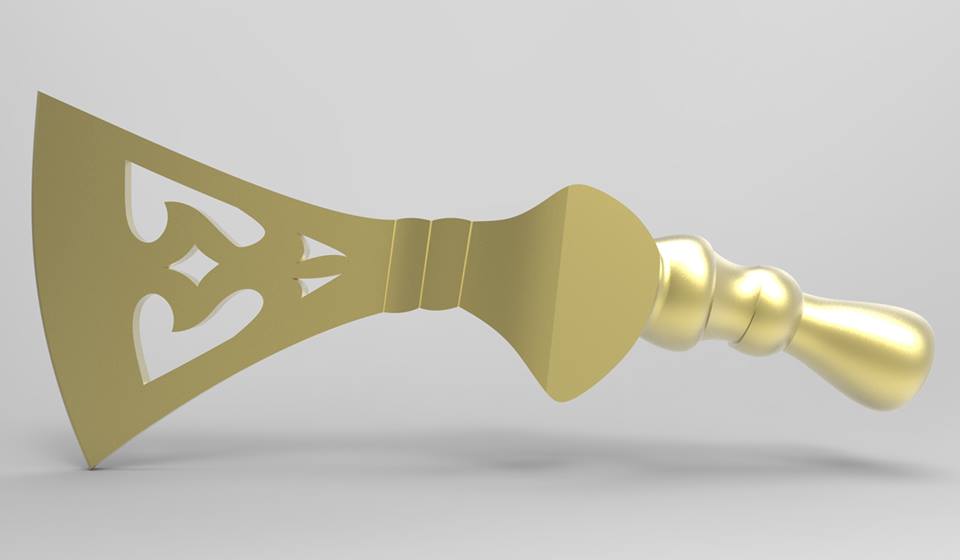
The axe from Falköping Museum. Source: Paulsen 1956: Abb. 25d; Vlasatý 2020a.
- Mikulčice, Czech Republic
The 1994 grave hid a remarkable T-shaped axe (ref. No. 341/90), which had a triangular hole in the blade and a twisted neck. The axe burned down during a fire in the Mikulčice deposit in 2007.
Literature: Luňák 2010: 50, Obr. 22.
Sekera z Mikulčic. Source: Luňák 2010: Obr. 22.
- Borovan, Bulgaria
One of the Jotov type 5A axes from the Borovan locality is equipped with a rectangular hole. No further information is known.
Literature: Jotov 2004: кат. No 584, табло L.
The axe from Borovan. Source: Jotov 2004: кат. No 584, табло L.
- Nagypall I, Hungary
One of the axes from the Avar burial ground of Nagypall I has a rectangular hole. The axe comes from grave 41.
Literature: Kiss 1977: Pl. XXX.41.2.
The axe from Nagypall I. Source: Kiss 1977: Pl. XXX.41.2.
- Nevolinskyj cemetery, Russia
Grave 157 from the cemetery near the village of Nevolino contained a narrow axe with a faceted hammer, the blade of which is provided with a rectangular hole and two circular holes.
Literature: Goldina 2012: Tab. 73.2, 191.1.
The axe from the site of Nevolino. Source: Goldina 2012: Tab. 191.1.
- Nevolinskyj cemetery, Russia
Grave 186 from the cemetery near the village of Nevolino contained a narrow axe with a faceted hammer, the blade of which is provided with a triangular hole.
Literature: Goldina 2012: Tab. 92.9, 191.3.
The axe from the site of Nevolino. Source: Goldina 2012: Tab. 191.3.
Cross axes
A cross axe (Danish korsøkse) is a designation for a small group of Petersen axes of the L/M type, whose blades are perforated to form a cross. The types can be generally dated to approximately 950–1050 (Petersen 1919: 46–47), while cross axes were dated more accurately to the second half of the 10th century (Paulsen 1956: 67). So far, six pieces of these axes are known – three come from Denmark, two from Sweden and one from Poland. The distribution is therefore spread in the Baltic region. In terms of the frequency of these axes, they represent a marginal topic in the corpus of Scandinavian weapons, and even within the L/M types they cannot make up more than 1% of the total. It would be difficult to find a more eloquent statistic than Kotowicz’s analysis, which shows that only 0.45% of all Polish axes from the period 6th – 1st half of the 13th century were somehow decorated with a cross (Kotowicz 2013: 41).
The scientific literature pays surprisingly little attention to these axes. This is partly due to the fact that the finds are of an older date, which limits the possibilities of interpretation. Therefore, it is appropriate to list the literature that concerns this phenomenon. The website of the Danish National Museum reads:
“Research indicates that such axes were robust enough for practical use. However, it is more likely that they were reserved for ceremonial purposes. The owners of these cross axes were not necessarily Christian, but the axes reflect the strong Christian currents that existed in this part of the Viking period.“
In the book “From Viking to Crusader: Scandinavia and Europe 800-1200” (Roesdahl – Wilson 2000: 279, no. 194) we find the same information and learn that axes “could have been used for ceremonial purposes, as were axes inlaid with silver and gold [eg axes from Mamten or Trelleborg].” We also read that such “perforated axes are unusual in Scandinavian times in Viking Period.” Finally, the book informs us that “during Christian missions, weapons were rarely buried in graves, but even at the end of the 10th century, the ax could have been a symbol of the warrior class.”
In her study “Materiel kultur, identitet og kommunikation” (Pedersen 2008: 15–16), Anne Pedersen considers that “the practical function of cross axes has been subordinated to symbolic significance“, and also deals with their distribution:
“Due to the relatively uniform shape of the axes and their geographical distribution, it can be argued that they were a symbol that was used and understood in a broader context in a large area of Scandinavia. We can also assume that the few men who owned such an axe were part of a closer community, and the axe was thus a symbol of loyalty that was not limited to local space.“

This is in line with Piotr Kotowicz’s study “The Sign of the Cross on the Early Medieval Axes – A Symbol of Power, Magic or Religion?“. He puts perforated axes into the broader context of axes decorated with crosses and shows that this is a northern European phenomenon of 6th to mid-13th century and that there was more frequent storage of axes with the dead after the Christianization of Scandinavia, which is also reflected by perforated axes (Kotowicz 2013: 42). Kotowicz understand cross axes as strictly Viking phenomenon. However, he does not state that the deposit of axes ended up in Scandinavia during the 11th century. This increase of axes in graves is truly remarkable and, according to Kotowicz, is related to the fact that the axe has become a symbol of the warrior profession, which can be compared to the Varagian Guard (sometimes referred to in period sources as pelekophori, literally “axe carriers”), in which Petersen’s type L/M axes were used for various ceremonies and saluting the monarch:
“Guardsmen were holding them in the right hand, leaning the blade against the left wrist. When the Emperor came, they brought up the axes to lean them on their right shoulders. During the time of the name-day of the Emperor the Varangians saluted him and banged their axes, which emitted rhythmical sound.” (Kotowicz 2013: 52)
The distribution of axes along the Baltic Sea and the timing support this theory. Kotowicz also suggests that the use of perforated axes may be related to the cult of St. Olaf (Kotowicz 2013: 53). However, due to its use in the second half of the 10th century, we cannot agree with that. In addition to the above information, we can add that the hole in the blade certainly offered interesting options for attaching the case protecting the blade.
A Byzantine ivory plate depicting a man, apparently a member of Varangian Guard, with a two-handed axe and a sword. The axehead seems to be perforated. Dated around the year 1000. Taken from Wamers 2018: Abb. 1.
We hope you liked reading this article. If you have any question or remark, please contact us or leave a comment below. If you want to learn more and support our work, please, fund our project on Patreon, Buymeacoffee or Paypal.
Bibliography
Brøndsted, Johannes (1936). Danish inhumation graves of the Viking Age. In: Acta Archaeologica VII: 81–228.
Danič 2015 = Данич А.В. (2015). Классификация средневековых топоров Пермского Предуралья // Труды КАЭЭ. Вып. X. Пермь. С. 71–124
Ewing, Thor (2006). Viking Clothing, Stroud.
Goldina 2012 = Голдина, Р. Д. (2012). Неволинский могильник VII-IX вв. в Пермском Предуралье, Ижевск.
Hansson, Pär (1983). Jägarbacken (Borrarbacken). Ett gravfält från yngre järnålder, Örebro.
Chalikov 1985 = Халиков, А. Х. (1985). Культура Биляра, булгарские орудия труда и оружие X–XIII вв., Москва.
Izmailov 1997 = Измайлов, И. Л. (1997). Вооружение и военное дело населения Волжской Булгарии X – начала XIII вв, Казань.
Jotov 2004 = Йотов, Валери (2004). Въоръжението и снаряжението от Българското средновековие VII— XI в., Варна.
Kiss, Attila (1977). Avar cemeteries in county Baranya – Cemeteries of the Avar period (567-829) in Hungary 2, Budapest.
Kočkarov 2006 = Кочкаров, У. Ю. (2006). Боевые топоры Северо-Западного Предкавказья VIII-XIV вв. // Arcaucasica.ru –археология Кавказа [online]. [cit. 2020-06-29].
Kotowicz, Piotr N. (2013). The Sign of the Cross on the Early Medieval Axes – A Symbol of Power, Magic or Religion? In: Marek, Lech. Weapons Brings Peace? Warfare in Medieval and Early Modern Europe, Wratislavia Antiqua 18, Wrocław, 41–55. Available at: online.
Kotowicz, Piotr N. (2014). Topory wczesnośredniowieczne z ziem polskich : Katalog źródeł, Rzeszów.
Kotowicz, Piotr N. (2018). Early Medieval Axes from Territory of Poland, Kraków.
Luňák, Petr (2010). Výzdoba velkomoravských železných předmětů, Brno: Masarykova univerzita [diplomová práce].
Paulsen, Peter (1956). Axt und Kreuz in Nord- und Osteuropa, Bonn.
Pedersen, Anne (2008). Materiel kultur, identitet og kommunikation. In: Roesdahl, Else – Schjødt, Jens P. Beretning fra syvogtyvende tværfaglige vikingesymposium, 7–26.
Pedersen, Anne (2014). Dead Warriors in Living Memory. A study of weapon and equestrian burials in Viking-age Denmark, AD 800-1000, Publications from the National Museum. Studies in Archaeology & History Vol. 20:1 2. (Catalogue), Copenhagen.
Petersen, Jan (1919). De Norske Vikingsverd, Kristiania.
Roesdahl, Else – Wilson, David M. (2000). From Viking to Crusader: Scandinavia and Europe 800-1200, Uddevalla.
Schiørring, Ole (1978). Korset i øksen. In: Skalk 1978/6: 28–29.
Thunmark-Nylén, Lena (1998). Die Wikingerzeit Gotlands II : Typentafeln, Stockholm.
Thunmark-Nylén, Lena (2006). Die Wikingerzeit Gotlands III: 1–2 : Text, Stockholm.
Thunmark-Nylén, Lena (2000). Die Wikingerzeit Gotlands IV:1–3 : Katalog, Stockholm.
Vlasatý, Tomáš (2015). Organic axe sheaths of 9th-12th century. In: Project Forlǫg: Reenactment and Science [online]. [cit. 2020-06-29]. Available at: https://sagy.vikingove.cz/en/axe-sheaths/.
Vlasatý, Tomáš (2020a). The Axe from “Falköping Museum”. In: Project Forlǫg: Reenactment and Science [online]. [cit. 2020-06-29]. Available at: https://sagy.vikingove.cz/the-axe-from-falkoping-museum/
Vlasatý, Tomáš (2020b). Metal Axe Sheaths. In: Project Forlǫg: Reenactment and Science [online]. [cit. 2020-06-29]. Available at: https://sagy.vikingove.cz/metal-axe-sheaths/
Vlasatý, Tomáš (2023). Catalog of 8th-12th century perforated axes. In: Project Forlǫg: Reenactment and Science [online]. [cit. 2023-06-29]. Available at: https://sagy.vikingove.cz/en/catalog-of-8th-12th-century-perforated-axes/
Wamers, Egon (2018). Pelekyphoros – ein »Waräger« aus Köln. In: Archäologisches Korrespondenzblatt 48, 2, 265-280.





